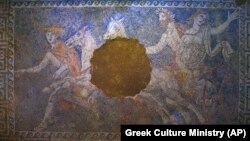A vast ancient tomb once thought to possibly house the remains of Alexander the Great contains bones of a woman, a newborn baby and two men and fragments of a cremated person, the Greek culture ministry said on Monday.
Speculation that the limestone grave in the Amphipolis tomb site might belong to the legendary Alexander, to one of his generals or to family members reached fever pitch in recent months as archeologist kept unearthing tantalizing finds.
The Amphipolis site, believed to be the largest ancient tomb to have been discovered in Greece, dates back to Alexander's era, around 300-325 B.C.
The ancient conqueror died in Babylonia -- in present day Iraq -- in 323 B.C. after a military campaign across the Middle East out to present-day Pakistan. His burial site is not known, but historians place it in the Egyptian city of Alexandria.
The culture ministry said research on the tomb's bones showed the buried woman was over 60 years old and about 1.57 meters tall while the two men were aged 35 to 45 years old.
One of the men had cut marks in his left chest that were most likely from mortal injuries inflicted by a knife or small sword, the ministry said. The men had an estimated height of 1.62 to 1.68 meters.
Further testing
The few burned bone remains of the fifth interred person, who was cremated, could not reveal the person's gender and authorities said further testing would be carried out.
Further analysis will also be done on the bones of the woman and two men to determine if they were related.
"Part of the analysis will look into a possible blood relationship ... but the lack of teeth and cranial parts that are used in ancient DNA analysis may not allow for a successful identification," the ministry said.
Excavations at the site near Greece's second city of Thessaloniki began in 2012 and captured global attention last August when archaeologists announced the discovery of a vast tomb guarded by two sphinxes and circled by a 497-meter marble wall.
Since then the tomb has also yielded a colorful floor mosaic depicting the abduction of Persephone, the daughter of Zeus, the supreme deity of ancient Greece, as well as two sculpted female figures known as Caryatids.






